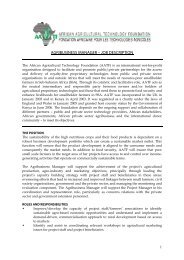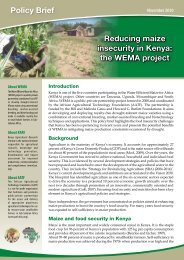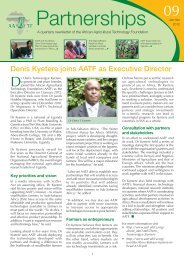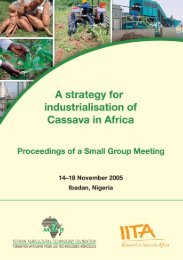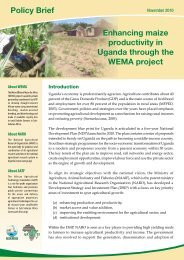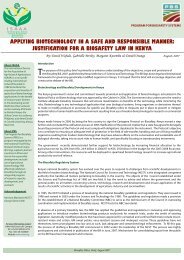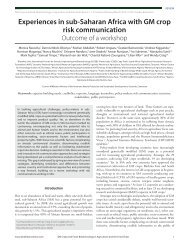Baseline Study of Striga Control using IR Maize in Western Kenya
Baseline Study of Striga Control using IR Maize in Western Kenya
Baseline Study of Striga Control using IR Maize in Western Kenya
You also want an ePaper? Increase the reach of your titles
YUMPU automatically turns print PDFs into web optimized ePapers that Google loves.
Alene and Hassan (2003) for maize production <strong>in</strong> western Ethiopia obta<strong>in</strong>ed a positive andsignificant <strong>in</strong>fluence <strong>of</strong> education on technical efficiency.The relationship between age and technical <strong>in</strong>efficiency was non-l<strong>in</strong>ear. That is, youngfarmers tend to become more efficient as they ga<strong>in</strong> experience, but after a certa<strong>in</strong> age, their<strong>in</strong>efficiency beg<strong>in</strong>s to <strong>in</strong>crease with age. However, the non-l<strong>in</strong>ear effect <strong>of</strong> age on technical<strong>in</strong>efficiency is not significant. Farm size had a similar and even significant effect on farmer<strong>in</strong>efficiency. That is, as farm size <strong>in</strong>creases from smaller landhold<strong>in</strong>gs, technical <strong>in</strong>efficiencydecl<strong>in</strong>es, but after a certa<strong>in</strong> land size, <strong>in</strong>efficiency beg<strong>in</strong>s to <strong>in</strong>crease with farm size. It canthus be concluded that the relationship between farm size and technical efficiency exhibits an<strong>in</strong>verted U shape. A lot <strong>of</strong> empirical work has been carried out to test the <strong>in</strong>verse farm sizeefficiencyhypothesis, but such a non-l<strong>in</strong>ear relationship has not been explored. Rather, al<strong>in</strong>ear relationship has been assumed and results have been mixed. For <strong>in</strong>stance while Squiresand Tabor (1991), and Llewelyn and Williams (1996), found no significant associationbetween farm size and technical efficiency <strong>in</strong> the Java area <strong>of</strong> Indonesia, Daryanto et al(2002), found a negative and significant relationship between farm size and technicalefficiency. In Indian agriculture, while Huang and Bagi (1984), Ray (1985), and Kalirajan(1991), obta<strong>in</strong>ed no significant association between farm size and technical efficiency, Coelliand Battese (1996), obta<strong>in</strong>ed a positive and significant <strong>in</strong>fluence <strong>of</strong> farm size on technicalefficiency.6.3. Technical efficiency estimatesTables 6.3–6.5 present the summary statistics <strong>of</strong> technical efficiency predictions by prov<strong>in</strong>ce,district and gender. The results show that the sampled farmers achieved an average technicalefficiency <strong>of</strong> 62%, <strong>in</strong>dicat<strong>in</strong>g substantial <strong>in</strong>efficiencies <strong>of</strong> maize production <strong>in</strong> western<strong>Kenya</strong>. There are only slight gender and location differentials <strong>in</strong> technical efficiency. Maleheaded households have an average technical efficiency <strong>of</strong> 63%, whereas female headedhouseholds achieved 60% efficiency. This variation is more apparent <strong>in</strong> Nyanza (64% vs.58%) than <strong>in</strong> <strong>Western</strong> (64% vs. 62%). While the sample maize producers <strong>in</strong> Nyanza achieved61% efficiency, those <strong>in</strong> <strong>Western</strong> achieved an average technical efficiency <strong>of</strong> 63%,confirm<strong>in</strong>g the higher maize productivity <strong>of</strong> farmers <strong>in</strong> <strong>Western</strong>. Technical efficiencyvariations across districts are more apparent than variations across prov<strong>in</strong>ces. Averageefficiency estimates range from 55% for Kisumu <strong>in</strong> Nyanza to 66% for Bungoma <strong>in</strong> <strong>Western</strong>.The sampled maize farmers <strong>in</strong> Bungoma and Busia are relatively more efficient than those <strong>in</strong>the other districts <strong>in</strong> western <strong>Kenya</strong>.Table 6.3. Technical efficiency distributions by prov<strong>in</strong>ce and gender (% households)Technical efficiency Prov<strong>in</strong>ceGender(%) All Nyanza <strong>Western</strong> Male headed Female headed≤25 5 7 3 4 925–50 19 20 18 19 1750–75 51 47 55 50 5375–100 25 26 24 27 21Mean 62 61 63 63 60M<strong>in</strong>imum 4 4 4 6 4Maximum 92 92 90 90 92Table 6.4. Technical efficiency distributions by prov<strong>in</strong>ce and gender (% households)Technical efficiency Nyanza<strong>Western</strong>(%) Male headed Female headed Male headed Female headed≤25 5 13 3 425–50 21 56 18 1844





